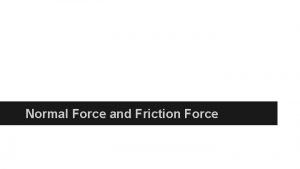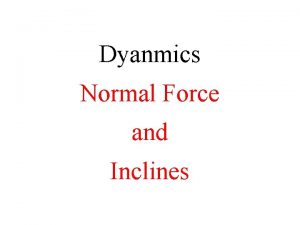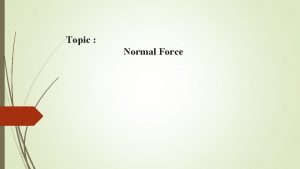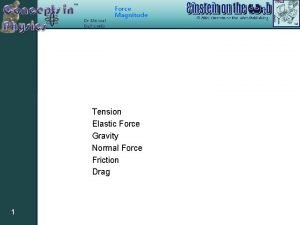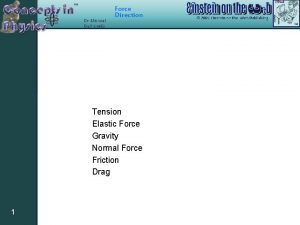Normal Force Normal force the force that arises









- Slides: 9

Normal Force

» Normal force: the force that arises in solids when surfaces come into contact. » It is an electromagnetic force between atoms which prevents an object placed on a solid surface from penetrating into the space the atoms of the surface already occupy. » The normal force is a CONTACT force exerted by a surface that is always perpendicular outward from the surface. Definition: Normal Force

» Consider a book placed on a wooden shelf. The shelf exerts a normal force on the book which is perpendicular to the shelf, whether the shelf is flat or fallen at an angle. . . FN FN Definition: Normal Force

» A 1 kg book is resting on a shelf. Calculate the magnitude of the normal force that the shelf exerts on the book. First, find the net force acting FN Fw=mg Example 1 on the book. ΣF=FN-Fw=ma but a=0 why? ? FN-Fw=0 FN=Fw=(1 kg)(9. 8 m/s 2)=9. 8 N

» Let the Box sit at rest on a flat Table. If other forces in addition to the Weight and Normal forces act in the vertical direction, then the Normal force and Weight are NO LONGER EQUAL. For instance, if we stood on the box, or if we attached a rope and pulled up slightly. In both these cases, the normal force must balance all other vertical forces so that the net vertical force = 0. Example 2

» Say a book weighing 2 Newtons is sitting on an inclined surface. How much of its weight is parallel to the surface, and how much is perpendicular to the surface? Finding Wǁ and W T

» A 1 kg book is resting on a shelf that is tilted 30°. Calculate the magnitude of the normal force that the shelf exerts on the book. FN Example 3

» In the previous example, if there is no friction on the shelf, the book will accelerate down the shelf. » What causes the acceleration? » Calculate the acceleration of the book. FN Example 4

» Draw a FBD and label all forces. » Find the components of each force that are parallel and perpendicular to your coordinate system » For the x components: ΣFx=max » For the y components: ΣFy=may » Remember a=0 for constant velocity (including rest). This could be in the xdirection, or y-direction, or both. Strategy










